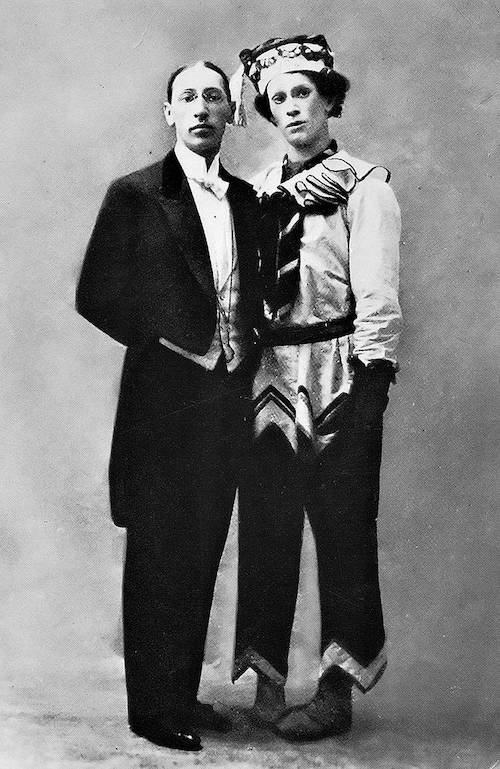New World Symphony takes a trip to the City of Light with “Stravinsky in Paris”

In 2019 the New World Symphony celebrated Igor Stravinsky with two programs of the 20th century master’s dance and concert works (featuring a collaboration with Miami City Ballet). This month New World is continuing that exploration of Stravinsky and the artistic currents that influenced him with two streamed concerts, filmed on the stage of the New World Center, the orchestral academy’s Miami Beach home.
On Saturday night “Stravinsky in Paris” offered a musical cornucopia of the cultural waves the Russian composer experienced in the French capital and his response to them. Artistic director Michael Tilson Thomas was the presentation’s genial host, providing lucid commentary and setting the musical selections in historical context.
Stravinsky first arrived in Paris in 1910 for the premiere of The Firebird, his first ballet score, by Diaghilev’s Ballets Russes. The young composer would become the rage of fashion-setting Parisian elites, the beginning of a remarkable creative career in the West spanning two continents.
From that landmark composition, the “Infernal Dance of Kachtcheï was heard, in a 2018 film excerpt of the complete work led by Tilson Thomas. This is prime MTT repertoire. While drawing plenty of raw power and reams of instrumental color from the players, his skill at highlighting individual sections and transparent solo lines distinguished this enticing highlight from past seasons.
Following World War II, Stravinsky made an arrangement of “Le Marseillaise” that was published on the front page of the French newspaper Le Figaro. Unlike his quirky, irreverent orchestration of “The Star-Spangled Banner,” which scandalized Boston audiences in the 1950’s, this solo violin version is a straightforward transcription. Natsuko Takashima played a well-schooled account of this curio.
While living in an apartment above the headquarters of the Pleyel piano company, Stravinsky became interested in the mechanical player piano. His brief vignette Madrid was originally written for piano roll and later rescored for orchestra. His talented son Soulima Stravinsky arranged this 1917 piece for two pianos. Andalusian-tinged motifs are woven into typical Stravinskyan rhythms that could have come from Pétrouchka. Wesley Ducote and Thomas Steigerwald gave an exuberant, high-energy reading of Soulima’s duo version.
The tango craze was in full force during Stravinsky’s French period. Jalousie, one of the most popular tangos was written by Danish composer-violinist-conductor Jacob Gade. Violinist Yefim Romanov played this iconic melody with the idiomatic affinity and ease of a salon or café player, accompanied in sparkling fashion by Ducote.
American ragtime and jazz made their mark in Europe during the first two decades of the 20th century. Conducting fellow Chad Goodman directed a small ensemble in The Easy Winners by Scott Joplin and Castle House Rag by popular bandleader James Reese Europe. Gunther Schuller’s arrangements of Joplin rags aided a rediscovery of that pioneering composer’s music in the 1970’s. It was wonderful to hear that edition of the now familiar music again. Goodman drew stylish playing with the lively articulation and flair of a good party band.
Stravinsky’s Ragtime for 11 instruments (1918) is his uniquely personal take on these American sounds. At once witty, dissonant and hard-driving, the work might be deemed “ragtime with a modern Russian accent.” Goodman brought rhythmic grit and nicely gaged dynamic variety to this attractive fusion score.
Three dances from L’Histoire du Soldat (The Soldier’s Tale), Stravinsky’s 1918 music theater work, took this cross-cultural pollination to a new level. In the play, the beleaguered soldier gives his violin to the devil in exchange for luxury. The tango, waltz and ragtime are solo violin excepts, joined by a sextet. Michael Turkell caught the humor of Stravinsky sendup of the tango and brought wide, schmaltzy vibrato to the waltz (which was definitely Russian rather than Viennese). The ragtime had swing and pulse, in no small part due to Jesse McCandless’ agile clarinet.
Stravinsky’s friendship with esteemed pedagogue Nadia Boulanger was celebrated with D’un matin du printemps by her tragically short-lived sister Lili Boulanger (1893-1918). This valedictory score exists in versions for violin and flute. (Yehudi Menuhin championed the violin edition in recital and recording.) There is more than a close resemblance to Debussy in this charmer. Flutist Johanna Gruskin’s silvery tone and precise leaps between registers was matched by the Gallic suaveness of Ducote’s accompaniment.
Stravinsky’s French contemporaries also were greatly influenced by jazz and popular culture. The second movement of Ravel’s Violin Sonata No. 2 in G Major is titled “Blues.” Michael Rau’s wonderful jazzy slides between notes and sense of vernacular influences were a refreshing alternative to the stilted, safe manner in which this movement is often performed. Ducote was an equally incisive partner.
Written in 1923, La creation du monde by Darius Milhaud predates Gershwin’s Rhapsody in Blue by a year as the first major classical work to be based on the sounds and vibrations of American jazz. Once frequently played, this ballet score has fallen off the radar in recent years.
Goodman conducted a worthy revival of this important work. Milhaud masterfully combined his French-schooled classicism with the swing of big bands and soulful vocal ruminations he encountered at clubs in London and Harlem. (Only Gershwin, Bernstein and the young Copland would also combine these diverse currents so adroitly.)
The opening alto saxophone solo sets a dreamlike atmosphere. Scott Meyers’ tonal glow and vitality were matched by the ensemble, led with vitality and snap by Goodman. The fast sections crackled and flute and clarinet solos were marked by beauty of sonority and almost vocal songfulness.
Stravinsky’s next chapter would take him to America in 1939 and that is the subject of the New World Symphony’s next program on March 13.
The New World Symphony presents “Stravinsky in America” streaming 7:30 p.m. March 13. nws.edu
Posted in Performances
Leave a Comment
Sun Mar 7, 2021
at 1:28 pm
No Comments